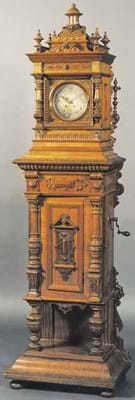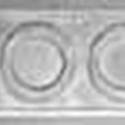All put together, the May 11 sale made for an unusual catalogue but, with an 86 per cent success rate at an average of nearly £280 per lot, once again, showed there is almost nothing that isn't keenly collected by someone. The more mainstream areas, predictably, took the top individual prices.
Leading the way was a nameplate from the 1920s locomotive Velocity. It came with a receipt from British Railways registering the fact that, following the breaking up of Velocity in 1963, its plate had been sold for 10 shillings. As that's less than a tenner in today's money, any disappointment when the plate went to a collector a little under estimate at £13,000, must be put into context.
The other big seller among the railwayana was a considerable improvement on estimate. This was a rare Great Western Railways totem from Cardiff General, the first Knowle expert Kegan Harrison had seen on the market. Estimated at £3000-3500, it sold to a collector at £6100.
The mechanical music was led by
the Symphonion-style, musical hall clock illustrated on this page. In a 6ft 6in (1.97m) tall elaborately carved walnut case, it played 11 1/4in (28.5cm) discs on a Sublime Harmonie movement and the Lenzkirch clock struck on a gong. A huge piece of late Victorian ingenuity, it made a top-estimate £6000.
Pre-Great War and '20s gramophones were in demand, in particular an E.M.G. Mark Xb table-top model with its original soundbox and the 2ft 5in (74cm) jointed papier-mâché horn which went at £3000 against a £1500-2000 estimate.
The sale opened with 90 lots of radios and radio equipment collected by a Buckinghamshire enthusiast and every lot sold. Prices ranged from £45 for an assortment of valves, headphones and magazines up to £1250 for a Sterling two-valve receiver type R1588 which had been estimated at just £80-120.
An offering of nearly 250 optical instruments ranged from 19th century magic lanterns through all the iconic camera names of the 20th century like Leica and Nikon, the humble Brownie and the professional Bolex cine cameras.
Among the earliest offerings was a 19th century Bi-Unial magic lantern, with lacquered mahogany body, brass-bound lenses and blue windows to the side doors. It sold within estimate at £1350.
Top seller was a rare Homeos Camera Outfit by Richard Frères Paris. Patented in 1913, this was the first 35mm stereo camera and only 1500 were made before manufacturing stopped in 1921. Estimated at up to £2500, it sold at £3100.
Finally a mention of 35 truncheons, court officers' tipstaffs and swagger sticks put together by George Carmichael QC, a famed Scottish advocate who died in 1970. Offered in 25 lots, they sold, as expected, in two and three figures with the top bid coming on a 19th century tipstaff.
With crown screw top over a brass cylindrical body, engraved J.Birchall, P.O, Bow Street and a ribbed wooden grip, the 9 1/2in (24.5cm) ornate truncheon took a mid-estimate £500.
Specialties of the house pull in the offbeat enthusiasts
THE way Bonhams’ (17.5% buyer's premium) empire has adapted to the received wisdom that specialisation is a key to today’s macro auction environment is to have niche markets catered for at different outposts. Among the areas catered for at the Midlands branch at Knowle are such widely known ones as mechanical music and railwayana and, in ascending degree of arcane nature, wireless sets, optical instruments, firemarks, truncheons and tipstaffs.








